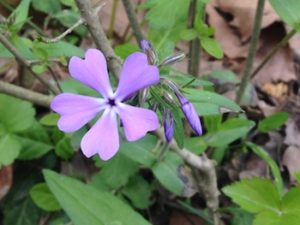Volume 23 Issue 1, Spring 2018
by Kelsey Gentry

Wild Blue Phlox (Phlox divaricata)
Photo by Kelsey Gentry
Walking through the woods on a warm spring day is a wonderful way to experience the wide array of wildflowers as they begin to wake from their winter slumber. Among these delicate beauties grows a diverse family of plants known as Phlox, or Polemoniaceaei. Phlox is a garden favorite, and a wide variety of native and cultivated species can be found across the country. Three species are native to Northern Virginia, each with its own unique characteristics.
Wild Blue Phlox (Phlox divaricata), the most commonly known, is found in woodlands and forested areas. Its beautiful blue flowers and delightful fragrance make it a wonderful addition to any garden. P. divaricata goes well with other perennials and makes an especially good ground cover around bulb flowers. Blooming March through May, it is best suited to partially shaded, drier areas and can tolerate most soil types.
Moss Phlox or Creeping Phlox (Phlox subulata) grows low and spreading and is typically found in rocky or sandy areas. It produces a gorgeous carpet of white, pink or purple flowers in the spring, and its leaves retain some of their green throughout the winter. It is well suited for use in garden borders, as a ground cover, or to drape over the edge of a rock wall or garden bed. P. subulata blooms March through June, grows best in a sunny, dry area and can tolerate most soil types.
Garden Phlox or Fall Phlox (Phlox paniculata), found in meadows, has big showy clusters of pink or purple flowers and grows upright on a stalk. As indicated by its common name, it is a favorite in many gardens for both its delightful fragrance and beautiful blooms, which last all summer and into early fall. It is ideal for smaller gardens and tight spaces because it will not spread and pairs well with other native perennials. P. paniculata blooms June through September and is best suited to sunny areas with moist, loamy soil.
While phloxes are definitely selected by gardeners due to their pleasing aesthetics, they also offer several benefits for wildlife, making them ideal for native plant gardens. Their colorful flowers attract bees, butterflies and hummingbirds to partake of their sweet nectar, while their roots provide a tasty snack for voles and rabbits. Watch out for rabbits in your garden, though — those critters can destroy your phlox!
Though phlox is beautiful, it also has its challenges. Phlox Bugs (Lopidea davisi) will feed on leaves and stems and can destroy the plants. One way to prevent infestations is to cut back any infested stems or leaves and dispose of them, also cleaning up stem and leaf litter of phlox and surrounding plants in the winter to eliminate a hiding place and breeding ground for the bugs. Phlox is also susceptible to powdery mildew and root rot, though P. paniculata and P. subulata are known to have a stronger resistance to powdery mildew.
With its beautiful, fragrant blooms and magnetism for hummingbirds and butterflies, the entire phlox family is well worth adding to any Loudoun native garden.
Resources:
https://www.novaregion.org/DocumentCenter/View/10615
http://www.missouribotanicalgarden.org/PlantFinder/PlantFinderProfileResults.aspx?basic=phlox
https://www.wildflower.org/plants/result.php?id_plant=PHDI5
https://plants.usda.gov/core/profile?symbol=PHDI5
http://vaplantatlas.org/index.php?do=browse:family&id=158
http://www.virginia.edu/blandy/VirginiaNativesForButterflies.pdf

